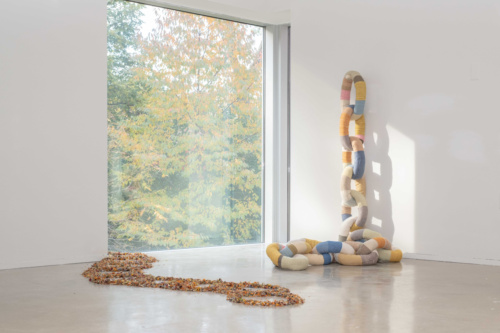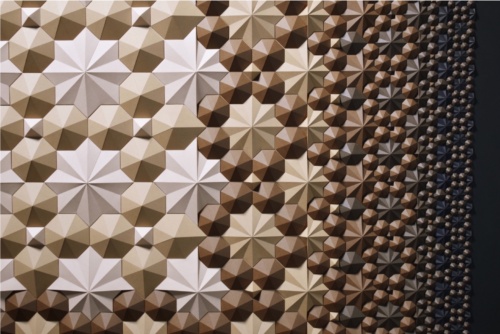At the Birthplace of Modernism, A Rebirth
Cranbrook Art Museum to reopen on November 11th after a two-year, $22 million restoration and expansion – the first since the landmark Eliel Saarinen building opened in 1942.
New Wing will allow the museum’s full collection of design, textiles, ceramics and fine art to be displayed and accessed, underscoring the pedagogical mission of Cranbrook by bringing the collection to life for a new generation of artists, students, and visitors.
Inaugural exhibition to create dialogue between the magnificent collection and contemporary works.
Bloomfield Hills, Michigan – On November 11, 2011, Cranbrook Art Museum will reopen after a two-year construction project that encompassed both a complete renovation of its landmark 1942 Eliel Saarinen-designed building and a new 20,000-square-foot Collections Wing. While the restored galleries (including a new state-of-the-art climate control system and other sophisticated museum technologies) will continue to provide the Art Museum with a venue for innovative and thought-provoking exhibitions, the new Collections Wing will house and make accessible the Museum’s celebrated permanent collection of nearly 6,000 works of art, architecture, and design from the Arts and Crafts Movement to the present. Cranbrook Educational Community’s extensive Archives and Cultural Properties collections will also move to the facility, creating a dynamic new center for exhibition, research, and educational programming.
HISTORY OF CRANBROOK ACADEMY OF ART, “AMERICA’S BAUHAUS”
Founded by newspaper magnate George Gough Booth and his wife Ellen Scripps Booth, Cranbrook Academy of Art and Art Museum represent an ongoing educational experiment that the whole Cranbrook Educational Community embodies—”an original and radical plan to integrate all the arts in a perfect ensemble,” according to Museum Director Gregory Wittkopp.
Cranbrook Academy of Art has been described as “America’s Bauhaus,” in recognition of the singular impact the school – one of the nation’s leading graduate schools of art, architecture, and design – has as a place of artistic creation. Charles and Ray Eames, Florence Knoll, Harry Bertoia, Ralph Rapson, and Eero Saarinen created mid-century modernism at Cranbrook. Michael and Katherine McCoy started Product Semantics at the school. Daniel Libeskind, Jun Kaneko, Hani Rashid, Nick Cave, Richard De Vore, Tony Matelli, Niels Diffrient, Ed Fella, John Glick, Duane Hanson, Jack Lenor Larsen, and Lorraine Wild all studied or taught at Cranbrook. Today, the Academy graduates more than 70 young artists and designers each year. The school’s faculty of ten Artists-in-Residence are award-winning practitioners in their fields with work exhibited at some the world’s most distinguished venues, including the Venice Biennale, the Smithsonian Museum of American Art, the Victoria & Albert Museum, The Detroit Institute of Arts, the Museum of Modern Art, The American Academy of Arts, and many others.
As Reed Kroloff, Director of Cranbrook Academy of Art and Art Museum, says, “People may not realize it, but Cranbrook art and design is everywhere. Whether you’re sitting in an Eames office chair or riding in a new subway car in New York City, you are experiencing design by Cranbrook graduates [Antenna Design, which created the most recent subway cars, is co-directed by Masamichi Udagawa, a Cranbrook graduate]. The impact of this school on American life is ongoing and profound.”
The Art Museum represents the culmination of Booth’s plan. The Museum’s collection of art and objects includes sculpture, paintings, models and drawings, ceramics, glass, furniture, textiles, and metalwork, and it is renowned for its variety – with the decorative, applied and fine arts all represented–its depth, and its unrivaled quality. Among the many treasures owned by Cranbrook Art Museum are works by Agnes Martin, Donald Judd, Bridget Riley, Robert Rauschenberg, Roy Lichtenstein, Andy Warhol, Maija Grotell, Peter Voulkos, Eliel, Eero, Loja and Pipsan Saarinen, Harry Bertoia, Florence Knoll, Marianne Strengell, Marshall Fredericks, Carl Milles, Arthur Neville Kirk, Paul Manship, and William Morris.
RENOVATION AND EXPANSION
Designed originally by Eliel and Eero Saarinen (with later buildings by Steven Holl, Lake/Flato, Rafael Moneo, Peter Rose, and Tod Williams and Billie Tsien), Cranbrook is a National Historic Landmark, located on 320 acres of rolling, wooded landscape approximately 18 miles northwest of downtown Detroit. And, on a campus famous for its architecture, Cranbrook Art Museum is considered one of Eliel Saarinen’s masterpieces.
The complete renovation and expansion accomplishes two things, according to Museum Director Wittkopp. “On a fundamental level, we are making a commitment to the infrastructure of the museum by raising Saarinen’s masterwork to the standards of 21st-century museum practice, in terms of mechanical systems, lighting, communications, and other technology,” he says. “But Cranbrook is, ultimately, a community where art and life are inextricably linked, and we believe that a museum and its collections are important only if they can continue to inspire new generations of artists.” To that end, and in keeping with Cranbrook’s tradition as a center of educational innovation, the new Collections Wing creates a model that is unprecedented: a museum whose collections in their entirety are visible and accessible. “The Academy has always seen the collection as a critical component of our pedagogy,” explains Kroloff. “So we decided early on to create a very different kind of environment for viewing it. Instead of seeing only the fraction of the collection that most museums offer, our students, faculty, and visitors will have access to all 6,000 objects in a way that’s never been possible before. Cranbrook Art Museum and its collections will be an integrated teaching environment like no other.”
In order to accommodate this program, the building project encompassed two primary aspects: renovating and restoring the original Saarinen museum, and adding the 20,000-square-foot Collections Wing, where much of the collection will be displayed. Creating a conservation environment within the existing building required substantial improvements to achieve current standards for lighting, temperature, and humidity. Restoration of the Saarinen building also included a new roof, windows, and brick repair, as well as the disassembly and rebuilding of the building’s famed plazas and ceremonial exterior stairs, which will now include a snow melting system that eliminates the need for destructive winter salting. An original Saarinen-designed coffered gallery lighting system (believed to be the first of its kind, and the forerunner of Eero Saarinen’s revolutionary integrated lighting systems at the nearby General Motors Technical Center) was also restored.
The new Collections Wing is located to the northeast of the historic Saarinen museum and houses the new, visible collections spaces, a woodshop, photography studio, loading dock, and a 10’x15′ freight elevator to facilitate the transport of artworks within the building. A seminar/conference space is intended for focused instruction regarding the collection. The SmithGroup was the architect for both the restoration and the new building.
The $22 million-project at Cranbrook Art Museum was funded by Cranbrook Educational Community as one of several important restoration projects made possible by a recently completed $181 million Comprehensive Fundraising Campaign. Of this total, the Academy of Art and Art Museum raised nearly $46 million in annual and endowed support for programming, financial aid, faculty support, and new equipment. The $10 million lead gift to the Campaign was received from Maxine and Stuart Frankel and family.
REOPENING EXHIBITION
Since their founding, Cranbrook Academy of Art and Cranbrook Art Museum have been committed to catalyzing discourse surrounding cultural production, including art and design theory. The Museum will reopen on November 11, 2011 with an exhibition that will underscore this idea, while firmly establishing the relevance of Cranbrook and its collections today. The opening exhibition will juxtapose selections from the Museum’s collection with work by contemporary artists, setting up conversations between the pieces that will cross barriers of time, typology, and theoretical discourse.
About Cranbrook Educational Community
Cranbrook is an internationally renowned educational community dedicated to excellence in the arts, education, and science. George and Ellen Booth founded Cranbrook in the early years of the 20th century with the hope of realizing the ideals of the Arts and Crafts movement and creating a community where artists could live and work. Their ideas took concrete form when they donated a sizeable portion of their money and much of the estate they had named Cranbrook, to be used as an educational and cultural center. In 1904, the Booths commissioned Albert Kahn to design a house on the property in a style reflecting the American Arts and Crafts Movement. In 1925, Eliel Saarinen was commissioned to begin designing many of the buildings that unfolded throughout the property, with Swedish artist Carl Milles arriving in 1931 to grace the grounds with sculptures and fountains. Over its 107-year history, Cranbrook has earned an international reputation for educational and cultural excellence. The 320-acre historic campus today comprises the Academy of Art, Art Museum, Institute of Science, Cranbrook Schools, and other affiliated cultural and educational programs.
About Cranbrook Art Museum
Cranbrook Art Museum is a contemporary art museum, and an integral part of Cranbrook Academy of Art, a community of Artists-in-Residence and graduate-level students of art, design and architecture. The Art Museum, which was established in 1930 and opened at its current site in 1942, is Eliel Saarinen’s final masterwork at Cranbrook. Today, the Art Museum presents original exhibitions and educational programming on modern and contemporary architecture, art, and design, as well as traveling exhibitions, films, workshops, travel tours, and lectures by renowned artists, designers, artists, and critics throughout the year.
About Cranbrook Academy of Art
Cranbrook Academy of Art is the country’s top ranked, graduate-only program in architecture, design, and fine art. Each year, just 75 students are invited to study and live on Cranbrook’s landmark Saarinen-designed campus, which features private studios, state-of-the art workshops, a renowned Art Museum and 320 acres of forests, lakes, and streams, all a short drive from the art, design, and music scene of Detroit. The focus at Cranbrook is on studio practice in one of ten disciplines including Architecture, 2D and 3D Design, Ceramics, Fiber, Metalsmithing, Painting, Photography, Print Media, and Sculpture. The program is anchored by celebrated Artists- and Designers-in-Residence, one for each discipline, all of whom live and practice on campus alongside the Academy’s students. Dozens of internationally acclaimed artists, critics, curators, and gallerists visit each semester to supplement the individualized instruction, critiques, and mentoring by the Artists-in-Residence and Critical Studies Fellow. For more information, call us at 248-645-3300 or visit us at www.cranbrookart.edu.


